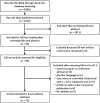Study quality on groin injury management remains low: a systematic review on treatment of groin pain in athletes
- PMID: 25633830
- PMCID: PMC4484372
- DOI: 10.1136/bjsports-2014-094256
Study quality on groin injury management remains low: a systematic review on treatment of groin pain in athletes
Abstract
Background: Groin pain in athletes is frequent and many different treatment options have been proposed. The current level of evidence for the efficacy of these treatments is unknown.
Objective: Systematically review the literature on the efficacy of treatments for groin pain in athletes.
Methods: Nine medical databases were searched in May 2014.
Inclusion criteria: treatment studies in athletes with groin pain; randomised controlled trials, controlled clinical trials or case series; n>10; outcome measures describing number of recovered athletes, patient satisfaction, pain scores or functional outcome scores. One author screened search results, and two authors independently assessed study quality. A best evidence synthesis was performed. Relationships between quality score and outcomes were evaluated. Review registration number CRD42014010262.
Results: 72 studies were included for quality analysis. Four studies were high quality. There is moderate evidence that, for adductor-related groin pain, active exercises compared with passive treatments improve success, multimodal treatment with a manual therapy technique shortens the time to return to sports compared with active exercises and adductor tenotomy improves treatment success over time. There is moderate evidence that for athletes with sportsman's hernia, surgery results in better treatment success then conservative treatment. There was a moderate and inverse correlation between study quality and treatment success (p<0.001, r=-0.41), but not between study quality and publication year (p=0.09, r=0.20).
Conclusions: Only 6% of publications were high quality. Low-quality studies showed significantly higher treatment success and study quality has not improved since 1985. There is moderate evidence for the efficacy of conservative treatment (active exercises and multimodal treatments) and for surgery in patients with adductor-related groin pain. There is moderate evidence for efficacy of surgical treatment in sportsman's hernia.
Keywords: Effectiveness; Groin; Methodological; Orthopaedics; Overuse.
Published by the BMJ Publishing Group Limited. For permission to use (where not already granted under a licence) please go to http://group.bmj.com/group/rights-licensing/permissions.
Figures


References
-
- Brukner P, Khan K, Brukner P. Brukner & Khan's clinical sports medicine. 4th edn. Sydney; New York: McGraw-Hill, 2012.
-
- Morelli V, Smith V. Groin injuries in athletes. Am Fam Phys 2001;64:1405–14. - PubMed
Publication types
MeSH terms
LinkOut - more resources
Full Text Sources
Other Literature Sources
Medical
